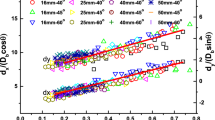Abstract
In order to accurately estimate the anti-penetration capacity of yaw-inducing bursting layer with irregular barriers on surface impacted by projectile, the theoretical model of attack angle and angular velocity for projectile impacting on irregular barrier was achieved according to the macroscopic relation of contact force versus contact time, in which the main factors such as the relative geometrical characteristics of projectile and irregular barrier, material property and impact velocity of projectile influencing on yaw-inducing effectiveness were considered. On the basis of considering synthetically the influences of attack angle, impact velocity, impact angle of projectile and uncontrolled free surface of target, the theoretical formulation of penetration depth for bursting layer with irregular barriers on surface impacted by projectile was presented by expressing the stress of an optional point on the nose of projectile according to the relation of stress versus velocity. The theoretical results indicate that in the case of oblique impact embodying effect of attack angle, the penetration depth is reduced with the increase of impact angle, attack angle or angular velocity, and penetration trajectory is also deflected obviously. The effectiveness of angular velocity influencing on penetration depth is increased with impact velocity increasing. The theoretical results are in good agreement with test data for low impact velocity.
Similar content being viewed by others
References
SONG Li-**, WANG Hua. Development of precisely guided penetration weapons in USA [J]. Winged Missiles Journal, 2000, (1): 40–44. (in Chinese)
AUSTIM C F, HALSEY C C, CLODT R L. Protection systems development [R]. Tyndall Air Force Base, 1982.
ROHANI B. Penetration of kinetic energy projectiles into rock-bubble/boulder overlays [R]. Waterways Experiment Station, 1987.
GELMAN M D, RICHARD B N, ITO Y M. Impact of armor-piercing projectile into array of large caliber boulders [R]. Waterways Experiment Station, 1991.
UNDERWOOD J M. Effectiveness of yaw-inducing deflection grids for defeating advanced penetrating weapons [R]. Air Force Civil Engineering Support Agency, 1995.
ROHANI B. Shielding methodology for conventional kinetic energy weapons [R]. Waterways Experiment Station, 1987.
CARGILE J D, CAMMINS T R. Effectiveness of yaw-inducing bar screens for defeating low length to diameter armor-piercing [R]. Waterways Experimental Station, 1992.
WANG Ming-yang, LIU **ao-bing, QIAN Qi-hu. An engineering calculation method for the depth of penetration of projectile in steel fiber reinforced concrete embedded with steel spheres [J]. Acta Armamentarii, 2002, 23(1): 14–18. (in Chinese)
LIU Rui-chao, HE Man-chao, REN Hui-qi. Effect of attack angle on a projectile’s penetration [J]. Transactions of Bei**g Institute of Technology, 2003, 23(1): 26–29. (in Chinese)
WANG Ming-yang, QIAN Qi-hu. Studies on the dynamic properties for granular medium under stress wave [J]. Explosion and Shock Waves, 1996, 16(1): 11–20. (in Chinese)
CHEN Wan-xiang, GUO Zhi-kun, QIAN Qi-hu. Yawing mechanism of projectile based on contact theory [J]. Journal of PLA University of Science and Technology, 2006, 7(5): 458–466. (in Chinese)
THORNTON C. Coefficient of restitution for collinear collisions of elastic-perfectly plastic spheres [J]. ASME J Appl Mech, 1997, 64: 383–386.
JOHNSON K L. Contact mechanics [M]. Cambridge: Cambridge University Press, 1985: 386–424.
CHEN Da-nian, Al-Hassani S T S. Effective friction coefficient during particle impact on memtal [J]. Engineering Mechanics, 2004, 21(5): 172–177. (in Chinese)
YIN Fang-lin, WANG Ming-yang, QIAN Qi-hu. Penetration depth of projectile oblique into target [J]. Explosion and Shock Waves, 1998, 18(1): 60–76. (in Chinese)
WANG Ming-yang, RONG **ao-li, QIAN Qi-hu. Calculation principle for penetration and perforation of projectile into rock [J]. Chinese Journal of Rock Mechanics and Engineering, 2003, 21(11): 1811–1816. (in Chinese)
CHEN Wan-xiang, GUO Zhi-kun. Anti-penetration characteristics of RPC shelter plates with irregular barriers on surface [J]. Explosion and Shock Waves, 2010, 30(1): 51–57. (in Chinese)
Author information
Authors and Affiliations
Corresponding author
Additional information
Foundation item: Project(20110490894) supported by the Postdoctoral Science Foundation of China; Project(50908228) supported by the National Natural Science Foundation of China; Project(51021001) supported by the Science Foundation for Creative Research Groups of China
Rights and permissions
About this article
Cite this article
Chen, Wx., Guo, Zk., Qian, Qh. et al. Penetration depth for yaw-inducing bursting layer impacted by projectile. J. Cent. South Univ. Technol. 19, 1002–1009 (2012). https://doi.org/10.1007/s11771-012-1103-5
Received:
Accepted:
Published:
Issue Date:
DOI: https://doi.org/10.1007/s11771-012-1103-5




